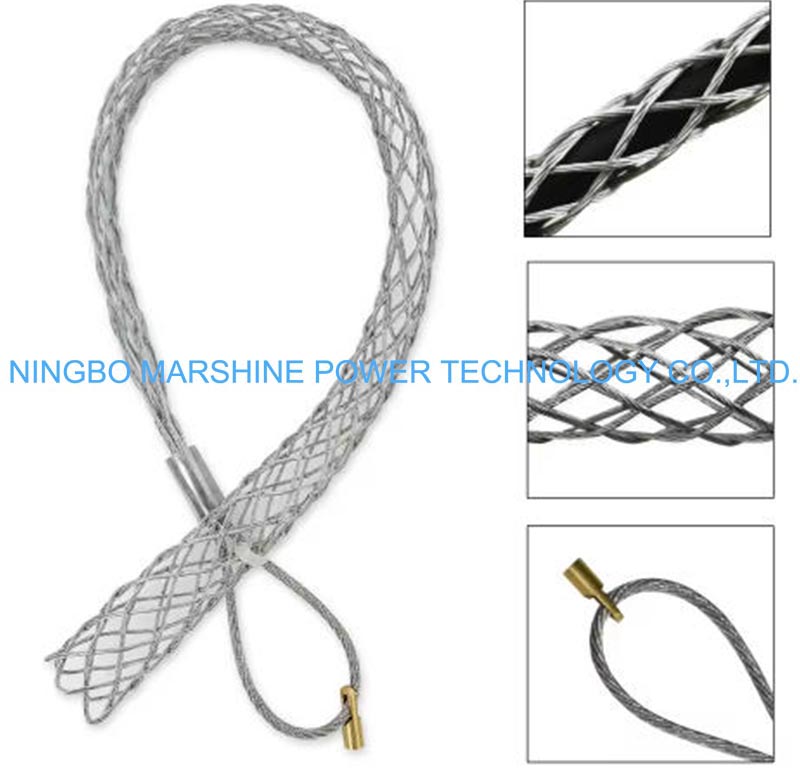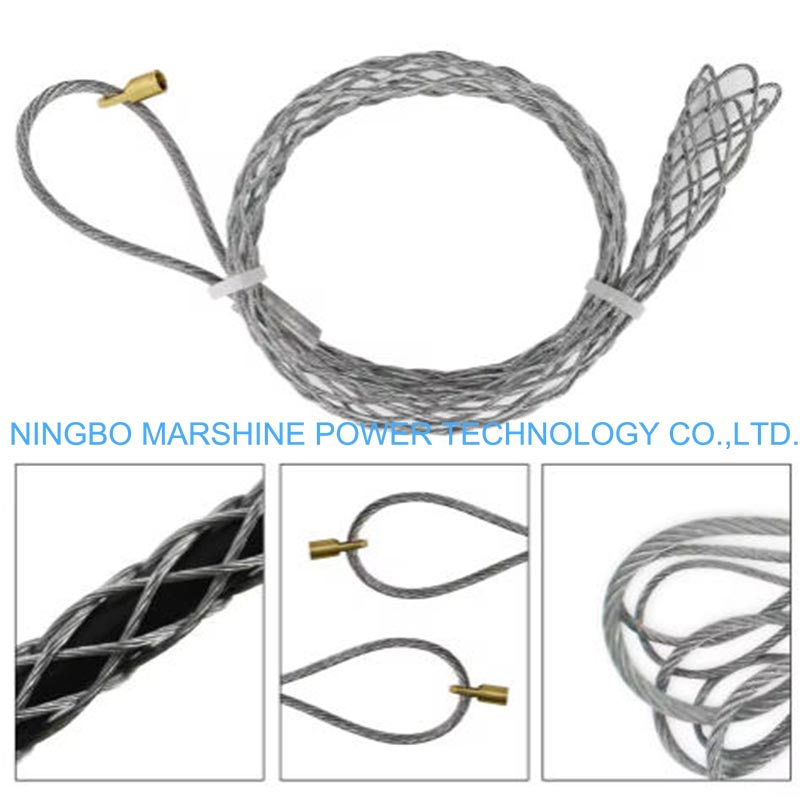
Selecting the right Cable mesh sleeve size makes a big difference. This choice depends mainly on the cable's outer diameter. It also considers the fit you want. A well-chosen sleeve provides excellent protection and a tidy appearance. For specific applications, like using a Cable Pulling Sock, precise sizing is equally important.

Choosing the right size for a cable mesh sleeve involves more than just a quick guess. You need to understand a few key measurements and terms. These metrics help you pick a sleeve that fits perfectly and does its job well.
Getting the exact size of your cable is the first crucial step. An accurate measurement ensures your cable mesh sleeve fits snugly. Professionals often use precision tools like calipers or micrometers for this task. These tools give you a very precise reading. When you measure, make sure to include the entire cross-section of the cable. This means measuring across all layers: the insulation, any shielding, and the outer jacket.
Sometimes, manufacturers have small allowable variations in cable size. It is wise to consider these tolerances. You should also check your measurements against technical data sheets or industry standards. This confirms the cable is right for your project.
For very precise work, especially with irregularly shaped cable joints, advanced methods exist. A non-contact 3D point cloud processing method can measure cable joints with high accuracy. This technique helps avoid surface damage and offers better precision than older tools. Traditional tools like vernier calipers or steel rulers can cause surface damage and are less accurate for professional needs.
You can also calculate the outer diameter for single-core cables. Just add the conductor's outer diameter to twice the insulation layer thickness and twice the sheath thickness. You can find these numbers in manuals or specifications, or measure them directly.
Every cable mesh sleeve has a "nominal diameter." This is its base size when it is not stretched or compressed. But the real magic of these sleeves comes from their "expansion ratio." This ratio tells you how much the sleeve can expand from its nominal size. It is a key factor for fitting different cable bundles.
For example, PET expandable braided sleeving often has an expansion ratio of 2 times. This means it can stretch to twice its original diameter. Other types, like Colors expandable sleeving made from PET monofilament, can expand even more, up to 300% of their initial diameter. PET braided wire sleeves typically expand up to 150% of their starting diameter. Understanding these ratios helps you select a sleeve that can cover a range of cable sizes or bundles.
Each cable mesh sleeve has a specific range of cable sizes it can handle. This range is defined by its minimum and maximum bundle diameters. The minimum bundle diameter is the smallest cable or group of cables the sleeve can fit tightly. If your cable is smaller than this, the sleeve might be too loose.
The maximum bundle diameter is the largest cable or group of cables the sleeve can comfortably cover. If your cable bundle is larger than this, the sleeve will be too stretched. This can reduce its protective qualities or even damage the sleeve. Staying within these limits ensures the sleeve provides optimal protection, looks neat, and lasts a long time.
Choosing the correct cable mesh sleeve type and size is crucial for effective cable management and protection. Different sleeve types offer unique benefits and require specific sizing considerations.
Braided cable mesh sleeves are very flexible. They easily fit into tight spaces and conform to various cable shapes. To size them, first measure your cable bundle's diameter. Use a caliper, ruler, or flexible tape. Remember the sleeving's ability to stretch. For example, PET expandable braided sleeves can expand to 1.5 times their resting size. Always check the manufacturer's specifications for minimum and maximum diameters. Also, ensure the sleeving can expand enough to slide over any large connectors or plugs. This might mean you need a larger diameter sleeve. Review product specifications for diameter range, length, and environmental resistances. Finally, test a small section of the sleeving to confirm the size and ease of installation. Braided sleeves allow wires to bend without damage. Their open weave protects cables and expands up to 150% of their original size. However, some materials like Polyphenylene Sulfide Monofilament (PPS) and Nomex are less flexible. This limits their adaptability for different sizing needs.
Expandable cable mesh sleeves offer great versatility. They are compatible with cable diameters from 2mm to 30mm. Specific sizes include 2mm, 3mm, 4mm, 6mm, 8mm, 10mm, 12mm, 16mm, 25mm, and 30mm. One common size has an inside diameter of 12mm (0.47 inches). Designs like 'expandable braided' and 'telescopic expandable' improve installation speed. You can also find 'open-end' or 'self-closing designs'. PET (Polyethylene Terephthalate) is a common material. Its braided structure allows up to 50% radial expansion. This accommodates various bundle diameters. For proper installation, select a sleeve with a diameter 1.5 times the bundle diameter. PET offers excellent thermal, flame, mechanical, and chemical resistance.
Heat shrink cable mesh sleeves require careful sizing. The final diameter of the heat shrink product should be smaller than the object it covers. However, its expanded diameter must be large enough to cover the area and any attached connectors. Cut the sleeve to length, allowing for at least a quarter-inch overlay over connectors. Also, account for longitudinal shrinkage. Most standard heat shrink tubing starts to contract between 90°C to 120°C (194°F to 248°F). Full shrinkage happens at slightly higher temperatures. The final size depends on the tubing's shrink ratio, like 2:1 or 3:1. The minimum expanded inside diameter (ID) must be greater than the largest diameter it needs to slide over. The maximum recovered ID must be less than the smallest diameter that needs full coverage.

Choosing the right size for your cable mesh sleeve makes a big difference. It ensures your cables stay protected and organized. This section helps you apply sizing principles to real-world situations.
Sizing for a single cable is usually straightforward. You simply measure the cable's outer diameter. Then, you pick a sleeve that matches this diameter, allowing for a snug or slightly loose fit based on your needs.
However, sizing for multiple cables presents a different challenge. You are bundling several cables together. This creates a larger, often irregular, shape. Many professionals use "conduit fill calculators" for this task. These tools help determine the right sleeve size for a bundle. They consider how easily you can pull wires through the sleeve. Remember to focus on the outer diameter of each cable's jacket, not the wire gauge. The wire gauge does not tell you the physical space the cable takes up.
You can also use a mathematical formula to calculate the bundle diameter. First, figure out the area of a single cable. You can do this with the formula: (cableDiameter * cableDiameter * Math.PI) / 4. Next, multiply this single cable area by the number of cables you have. This gives you the total bundleArea. Finally, calculate the bundleDiameter using Math.Sqrt((bundleArea * 4) / Math.PI). Convert this result to inches to select a suitable sleeve. This method helps you find a sleeve that can comfortably hold all your cables.
The fit of your cable mesh sleeve matters a lot. You can choose between a tight or a loose fit. Each option has its own benefits. A snug fit offers optimal insulation and protection for your cables. It keeps them secure and prevents movement. This is great for applications where you want maximum protection and a very neat appearance.
On the other hand, an overly loose or tight sleeve can reduce performance. An overly loose sleeve might not protect cables well. It could also look messy. An overly tight sleeve can be hard to install. It might also put stress on the cables or the sleeve itself. This could lead to damage over time. Consider your application's needs. Do you need maximum protection and a clean look? Go for a snug fit. Do you need more flexibility or plan to add more cables later? A slightly looser fit might be better.
Many people make common mistakes when sizing cable mesh sleeves. You can avoid these errors with careful planning.
One common mistake is not measuring accurately. Always use precise tools like calipers. Guessing the size often leads to sleeves that are too big or too small. Another error is forgetting about connectors or plugs. These parts are often wider than the cable itself. Make sure your chosen sleeve can slide over them.
People also sometimes ignore the expansion ratio of the sleeve. An expandable sleeve can stretch, but only so much. Always check the manufacturer's specifications for the minimum and maximum diameters. Not considering future cable additions is another pitfall. If you think you might add more cables later, choose a sleeve with a bit more room. This saves you from having to replace it. Finally, always match the sleeve material to your environment. For example, some materials offer better heat resistance. Choosing the wrong material can compromise protection. Taking these steps helps ensure your cable mesh sleeve works perfectly for your needs.
Accurate measurements and understanding sleeve specifications are crucial. They help you pick the right cable mesh sleeve size. The correct size protects your cables well. It also keeps them organized and looks professional. Always think about your project's specific needs for a perfect fit.
Accurate measurement ensures a perfect fit. It prevents sleeves from being too loose or too tight. This protects your cables best and makes them look neat.
Choose a tight fit for maximum protection and a clean look. A slightly looser fit works if you plan to add more cables later.
If too loose, the sleeve offers less protection and looks messy. If too tight, it is hard to install and can stress cables or the sleeve itself.
-
